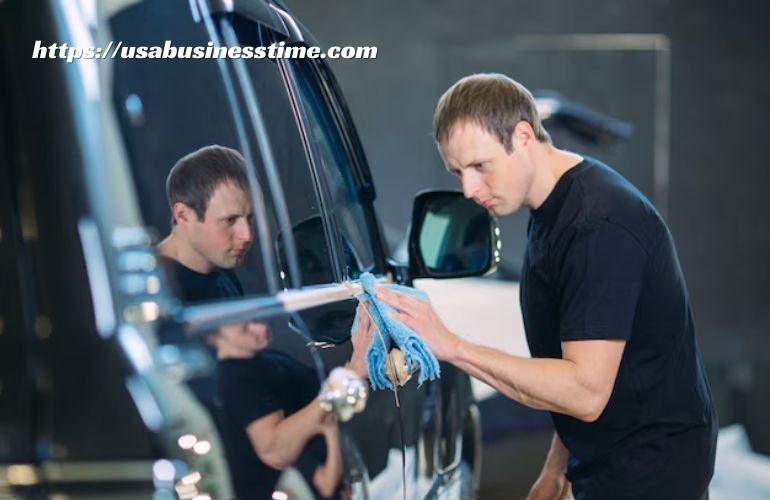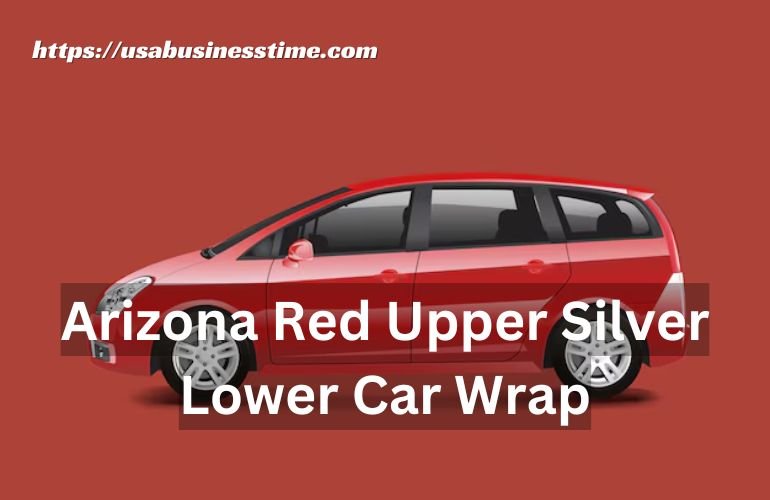Arizona Red Upper Silver Lower Car Wrap are a modern solution for transforming the appearance of vehicles without permanent changes. They offer a creative way to customize, protect, and enhance the overall aesthetic of your car. With various finishes, colors, and designs, wraps provide a flexible alternative to traditional paint jobs. This article explores the features, benefits, and practical aspects of car wraps, with a special focus on the Arizona Red Upper Silver combination.
Table of Contents
Arizona Red Upper Silver Lower Car Wrap: A Unique Choice
The Arizona Red Upper Silver Lower car wrap stands out as a striking design option for vehicle customization. The boldness of Arizona Red exudes energy and confidence, making the upper half of the vehicle visually commanding. This vibrant red pairs beautifully with the sleek, reflective properties of silver on the lower half, creating a balanced and harmonious aesthetic.

This color combination is not only visually appealing but also practical. The silver base enhances visibility on the road, reflecting light for added safety. The dual-tone finish allows for a sophisticated look that is adaptable to various car models, from sedans to SUVs and sports cars.
The design versatility of the Arizona Red and Silver wrap makes it suitable for both personal and professional use. Whether aiming to make a personal statement or align with branding needs, this combination offers a unique style that turns heads. Its appeal lies in the way it highlights the vehicle’s structure, emphasizing curves and edges for a polished appearance.
Choosing this wrap is about more than just aesthetics. It reflects a blend of creativity and functionality, giving vehicles a standout look while maintaining practicality and versatility for everyday use.
Customization Options for Arizona Red and Silver Wraps
The Arizona Red and Silver wrap offers a variety of customization options, allowing vehicle owners to tailor the design to suit their preferences. Different finishes, patterns, and design elements can be combined to create a personalized and unique appearance.
1. Finishes to Match Your Style
The choice of finish significantly impacts the overall look of the wrap. Matte provides a smooth, non-reflective surface that gives the car a modern and understated elegance. Glossy finishes add shine and depth, amplifying the vibrancy of the red and the sleekness of the silver. For those seeking a dramatic effect, a chrome finish enhances the reflective quality, making the vehicle stand out even more.
2. Creative Patterns and Designs
In addition to solid colors, the wrap can incorporate patterns such as geometric designs, stripes, or gradients. A gradient wrap that transitions seamlessly from red to silver creates a dynamic and flowing look. Stripes, such as silver racing lines on a red base, add a sporty edge, while geometric shapes can create a bold, futuristic design.
3. Coverage Options
The wrap can be tailored to cover specific parts of the vehicle. Full-body wraps are popular for a complete transformation, while partial wraps can highlight certain areas, such as the hood, roof, or doors. This flexibility allows owners to achieve their desired level of customization while working within their budget.
4. Graphics and Branding
For those using their vehicle for professional purposes, graphics and logos can be incorporated into the wrap. The contrast between the vibrant red and neutral silver provides an ideal background for showcasing business branding, slogans, or artwork.
5. Compatibility Across Car Models
The Arizona Red and Silver wrap works well with a range of vehicles, from compact cars to larger SUVs. The design can be adjusted to highlight the specific features of each model, emphasizing contours, edges, and unique characteristics.
This combination of design flexibility and style versatility makes the Arizona Red and Silver wrap a highly customizable option, ensuring that every vehicle can achieve a look that is distinct and eye-catching.
Installation Process: Professional vs. DIY
Installing a car wrap involves precision and careful handling to achieve a flawless result. Whether opting for professional services or taking a hands-on approach, understanding the steps and tools involved can make a significant difference in the outcome.
1. Preparing the Vehicle
Preparation is the foundation of a successful installation. The car must be thoroughly cleaned to remove dirt, grease, and wax that can affect the adhesive. Surface imperfections like scratches or dents should be addressed beforehand, as they may show through the wrap.
2. Professional Installation
Professional installers bring expertise and experience to the process. They use specialized tools and techniques to apply the wrap seamlessly, ensuring there are no air bubbles, wrinkles, or misalignments. Professionals also have access to climate-controlled spaces, which help maintain the ideal temperature and humidity for adhesive application.
Choosing professional services is particularly beneficial for complex designs or large vehicles. The investment often results in a high-quality finish that enhances the wrap’s longevity and appearance.
3. DIY Installation
For those who prefer to handle the installation themselves, having the right tools and patience is key. Tools like squeegees, heat guns, and cutting blades are essential for applying the wrap evenly and trimming excess material. The process involves carefully aligning the wrap, applying it section by section, and using heat to activate the adhesive and shape the material around curves and edges.
DIY installation may work well for simpler designs or partial wraps. However, it requires a steady hand and an eye for detail to achieve professional-level results.
4. Common Challenges During Installation
- Air Bubbles and Wrinkles: These can occur if the wrap isn’t applied evenly. Using a squeegee to smooth out the material can help.
- Misalignment: Careful measurement and planning before application can prevent issues with alignment.
- Cutting Errors: Trimming excess wrap must be done cautiously to avoid damaging the vehicle’s surface.
5. Tips for a Successful Installation
- Work in a dust-free environment to prevent particles from sticking to the adhesive.
- Maintain consistent pressure while applying the wrap to avoid uneven adhesion.
- Use heat sparingly to stretch the material, as overheating can damage it.
Deciding between professional installation and a DIY approach depends on the complexity of the design, budget, and personal skill level. Both methods can achieve great results with the right preparation and attention to detail.
Cost Breakdown and Durability of Car Wraps
Car wraps have gained popularity for their ability to transform a vehicle’s look while offering protection and value. Understanding the cost factors and durability can help in making an informed decision.
1. Factors Affecting Cost
The cost of a car wrap can vary widely based on several factors:
- Material Quality: Premium materials, such as vinyl with advanced adhesive technology, tend to be more expensive but offer better durability and a polished finish.
- Design Complexity: Custom designs, intricate patterns, or multi-layer wraps require more time and expertise, increasing the overall cost.
- Vehicle Size and Type: Larger vehicles, such as trucks or SUVs, need more material and labor, which contributes to higher expenses.
- Installation Method: Professional installation adds to the cost but typically ensures a flawless result, while DIY can be less expensive but may require additional tools and time.
On average, a full-body wrap for a standard vehicle can range from $1,500 to $5,000, depending on these factors. Partial wraps, such as just the hood or roof, are less costly and typically start at a few hundred dollars.
2. Durability of Car Wraps
The lifespan of a car wrap depends on the material used, maintenance, and environmental conditions. High-quality wraps can last between 5 to 7 years with proper care.
- UV Resistance: Wraps with UV-resistant properties are better suited for areas with intense sunlight, preventing fading and discoloration over time.
- Scratch Resistance: Durable wraps protect the original paint from minor scratches, adding to the car’s resale value.
- Weather Conditions: Wraps exposed to extreme weather, such as snow, rain, or high humidity, may wear out faster if not maintained correctly.
3. Comparing Wrapping to Painting
While painting offers a permanent solution, wraps are often more cost-effective and allow flexibility in design. Repainting a car can cost $3,000 to $10,000, depending on the quality and complexity. Wraps provide similar results at a lower cost with the added advantage of being removable if a new look is desired.
4. Value Beyond Aesthetics
Car wraps are not just about appearance. They safeguard the original paint, maintaining the vehicle’s integrity for resale or trade-in. A well-maintained wrap can often pay for itself by preserving the car’s condition and reducing the need for touch-ups or repainting.
Understanding these aspects helps to align the choice of wrapping with the desired budget and longevity. Investing in quality materials and proper installation can maximize the benefits of a car wrap.
Maintenance Tips to Prolong Your Car Wrap’s Life
Proper care and maintenance are key to keeping a car wrap looking its best and extending its lifespan. Regular attention to cleaning and protection can prevent wear and tear, ensuring the wrap remains vibrant and intact for years.
1. Regular Gentle Cleaning
Car wraps require specific cleaning methods to avoid damage to the material.
- Hand Washing: Washing by hand with a soft sponge and mild soap is the safest way to clean the surface. Avoid abrasive brushes or cloths that may scratch the wrap.
- Pressure Washing: While pressure washing can be used sparingly, the water pressure should be low, and the nozzle should be kept at a safe distance. High pressure or direct spraying at seams can loosen the adhesive.
- Avoid Harsh Chemicals: Products containing strong solvents or abrasives can cause discoloration or peeling. Always choose cleaning solutions designed for vinyl wraps.
2. Protection from Sun Exposure
Constant exposure to sunlight can cause fading, especially in areas with high UV levels.
- Parking in Shade: Whenever possible, park the vehicle in shaded areas or use a car cover to shield it from direct sunlight.
- Wax-Free UV Protectant: Applying a wrap-safe UV protectant can add an extra layer of defense against fading and cracking. Avoid wax-based products, as they may damage the surface.
3. Scratch and Damage Prevention
While wraps are durable, they can still be damaged by sharp objects or improper handling.
- Be Cautious with Tools: When working around the vehicle, avoid tools or objects that may accidentally scrape the wrap.
- Immediate Repairs: Address any damage, such as tears or peeling, promptly to prevent it from spreading. Professional assistance may be needed for larger repairs.
4. Routine Inspections
Inspect the wrap regularly for signs of wear, such as bubbling, peeling, or fading. Identifying issues early allows for timely repairs, which can extend the life of the wrap.
5. Avoid Automatic Car Washes
The brushes and rollers in automatic car washes can be harsh on wraps, causing scratches or peeling. Hand washing is a better option to maintain the wrap’s integrity.
6. Long-Term Care
For those planning to keep their wrap for several years, scheduling professional maintenance checks can help maintain its appearance. Experts can clean and recondition the wrap, addressing any minor issues before they become major problems.
By following these tips, the car wrap can retain its aesthetic appeal and protective qualities for its full lifespan, making it a worthwhile investment.
Environmental Impact and Conclusion
Car wraps present an environmentally conscious alternative to traditional paint jobs in various ways. Understanding their impact on the environment can guide decision-making while appreciating their aesthetic and practical advantages.

1. Reduced Environmental Harm During Application
Unlike painting, which often involves the use of solvent-based paints and volatile organic compounds (VOCs), car wraps eliminate the need for such chemicals. These VOCs contribute to air pollution and can be harmful to both the environment and human health. The application process for wraps is cleaner and produces minimal waste.
2. Longevity Reduces Waste
High-quality vinyl wraps last for years when properly maintained, reducing the need for frequent replacements or touch-ups. This durability contributes to less material waste over time compared to repainting, which may require periodic recoating due to chipping or fading.
3. Recyclable Materials
Many car wrap materials are recyclable, which allows for a more sustainable disposal process. After the wrap has served its purpose, components of the material can often be repurposed, lowering the overall environmental footprint.
4. Temporary Customization Without Permanent Impact
Since wraps are removable, they provide a temporary way to change a car’s look without altering the original paint permanently. This flexibility means that vehicles can be restored to their original condition without additional resources, making wraps an eco-friendly choice for customization.
5. Conservation of Resources
The production of vinyl wraps consumes fewer resources compared to manufacturing automotive paint. Additionally, wraps protect the underlying paint from wear and tear, reducing the need for extensive repainting or touch-ups, which would require additional raw materials and energy.
Conclusion
Car wraps offer a versatile, cost-effective, and visually appealing way to customize and protect vehicles. From the vibrant combination of Arizona Red and Silver to the wide range of finishes and designs available, wraps provide endless possibilities for personalization. With proper installation and maintenance, they can enhance a vehicle’s appearance while preserving its original paint. Whether for style, branding, or protection, car wraps deliver a modern solution that blends practicality with creativity, making them a smart choice for those looking to redefine their vehicle’s look.











